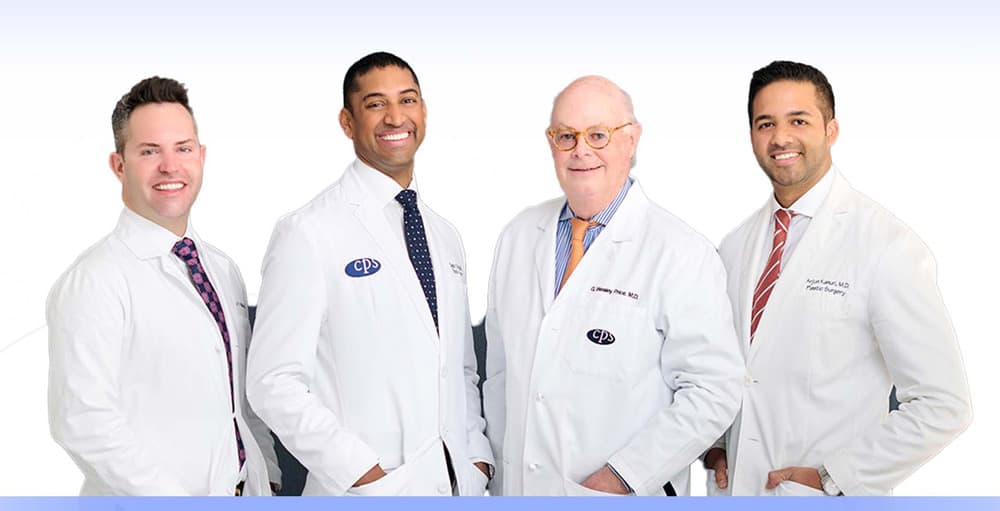Breast Reconstruction Surgery: Implants, Expectations, and More
Breast reconstruction is a procedure that restores the shape of the breast after a mastectomy. And… Read On
Center for Plastic Surgery
1945 Old Gallows Road, Suite 400
Tysons Corner, VA 22182
Phone: (703) 560-2850
Monday - Friday: 8 a.m.–5 p.m.
Center for Plastic Surgery
5550 Friendship Blvd, Suite 130
Chevy Chase, MD 20815
Phone: (301) 652-7700
Monday - Friday: 8 a.m.–5 p.m.
There are many approaches to breast reconstruction, so women in Washington, DC; Chevy Chase and Bethesda, MD; Arlington and Fairfax, VA; and surrounding areas who desire breast reconstruction are likely to be a candidate for at least one of these techniques. Many patients will benefit from a combination. As a candidate for reconstructive breast surgery, you will want to discuss all the appropriate options fully with your plastic surgeon. Learn more about the different options below:
This feature contains nudity. Please click OK to confirm you are at least 18 years of age and are not offended by such material.
Having a mastectomy for breast cancer can be a traumatic experience. We want to make sure you are aware of all the options available for restoration of the breasts and to reassure you about the positive results and benefits of breast reconstruction.
Modern breast reconstruction began in the 1960s with the development of the silicone breast implant. Four decades of research have resulted in a variety of breast reconstruction techniques and surgical procedures that are safer and more reliable than ever. With the enactment of the Women’s Health and Cancer Rights Act in 1998, health insurance companies are now required by law to provide coverage for breast reconstruction following mastectomy.
Most women who have had a mastectomy and are in otherwise good health are candidates for breast reconstruction. Your cancer surgeon and plastic surgeon will work together to choose the technique that will achieve the best results in terms of safety and aesthetics. Factors that influence the selection of a reconstruction technique include:
Breast reconstruction following a mastectomy has been a major advancement in the treatment of patients with breast cancer. With today’s mastectomy and plastic surgery techniques, almost all mastectomy patients can have breast reconstruction and enjoy the physical and psychological benefits that usually accompany this restorative procedure.
It is strongly recommended that any patient considering breast reconstruction seek a plastic surgeon who has specialized training and significant experience in breast reconstruction for mastectomy patients. If you are considering an advanced breast reconstruction procedure such as DIEP flap, you will need to find a plastic surgeon with specific training and experience in microsurgery techniques.
We are proud to have two breast reconstruction specialists on our surgical team at Center for Plastic Surgery. Dr. Samir Rao is experienced in multiple breast reconstruction techniques, including advanced prosthetic breast reconstruction using tissue expanders and implants, microsurgical breast reconstruction using the body’s own tissue, and oncoplastic surgery. Before joining Center for Plastic Surgery, Dr. Rao trained alongside internationally renowned breast reconstruction surgeons at Georgetown University Hospital and completed additional training in microsurgery at the Curtis National Hand Center.
Dr. Frank Albino specializes in natural tissue breast reconstruction using microsurgical techniques, including DIEP Flap, muscle-sparing TRAM Flap, thigh flaps (TUG, PAP), SIEA Flap, and fat-grafting, as well as prosthetic breast reconstruction using implant/tissue expander and direct-to-implant techniques. A graduate of the highly prestigious Integrated Plastic Surgery Residency Program at Georgetown University Hospital, Dr. Albino completed an additional year of intensive Fellowship training in reconstructive microsurgery for the breast and body at the University of Pennsylvania. He has also authored numerous peer-reviewed publications incorporating his research on advancements in autologous breast reconstruction.
Choose the experts that locals know and trust. Our multigenerational practice includes 4 board-certified plastic surgeons who provide the best possible care with state-of-the-art technology.
Meet Our Surgeons



For most patients, breast reconstruction will require two to three surgical procedures. The first and most involved procedure is the primary reconstruction of the breast mound or breast shape, which may be done in any of several ways. The second procedure usually consists of additional work on the breast shape or the placement of the implant. Any procedures needed to make the opposite breast more similar to the affected breast also would be done at this time. The final step usually is the nipple/areolar reconstruction. Location of the nipple/areolar area is critical to breast appearance and is usually done after all other reconstructive stages are completed.
Whether you undergo breast reconstruction at the same time as mastectomy, or as a separate procedure, depends on the nature of your breast cancer, your overall health, and the recommendation of your cancer surgeon. It is important, therefore, to choose a plastic surgeon who will communicate effectively and work closely with the cancer surgeon to determine the best course of treatment to achieve optimal results while prioritizing your safety and health.
Patients who are aware, prior to their surgery, of the possibility of breast reconstruction often elect to have the procedure started at the time of the mastectomy, with approval from the surgeon and oncologist. About three-fourths of our patients elect to begin breast reconstruction when the mastectomy is performed. Since the general surgeon must perform a complete mastectomy and also leave sufficient remaining healthy tissue to be used in the reconstruction, your plastic surgeon and general surgeon must work closely together.
The most obvious advantage of immediate reconstruction is that it allows you to avoid an additional hospital admission. Psychologically, mastectomy patients who have immediate breast reconstruction also experience less post-mastectomy depression, because their positive body image is retained. They also have the opportunity to balance the diagnosis of breast cancer against information about the positive aspects of breast reconstruction. Mastectomy patients who begin immediate reconstruction, however, sometimes have unrealistically high expectations about the results because they cannot see what the post-mastectomy results would be without reconstruction.
While patients who already have had a mastectomy cannot choose to have immediate reconstruction, they still are candidates for many of the same reconstructive techniques later on. Waiting has its own advantages. Not only is the mastectomy completely healed with delayed reconstruction, but the patient has had time to accomplish the following:
Both radiation therapy and chemotherapy can influence the type and timing of breast reconstruction. Radiation therapy affects the quality of the skin and may rule out or lend itself more easily to certain reconstructive procedures. Patients who are having chemotherapy may have to postpone the start or completion of reconstructive surgery until the chemotherapy is completed.
Expectations for results in breast reconstruction will vary with each patient. Our goal is to create a soft breast that has good shape and is reasonably symmetrical with the opposite breast. This is easier to achieve for some patients than others. The results depend upon the way the individual patient heals, the type of mastectomy, the reconstruction technique chosen and the patient’s existing tissue and opposite breast. All mastectomy patients should expect to lose some sensation over the chest wall, underarm and inner arm areas. While reconstruction will not improve sensation in these areas, it should not lessen it. Most patients can expect a breast volume that approximately matches the opposite breast, although there are some limitations on the size of a reconstructed breast.
Symmetry is a primary goal in breast reconstruction, but can only be obtained in some patients by altering the opposite breast. About 30 to 40% of mastectomy patients will choose opposite-breast surgery in order to match the shape and volume of the reconstructed breast. This improves appearance and sense of balance and makes the fitting of clothes and dressing easier. Some patients also find that a slight degree of asymmetry is acceptable and will choose not to alter the opposite breast. Some elect not to follow through with nipple/areolar reconstruction.
Approximately 30 percent of breast reconstruction patients have surgery on the opposite breast in order to maximize symmetry. When there is a significant difference between the size of the reconstructed and the opposite breast, many women choose to have the opposite breast reduced. Opposite-Breast Reduction is done in exactly the same way as ordinary breast reduction. The primary disadvantage of opposite-breast reduction is the additional surgical procedure and the resulting scars on the reduced breast. Fortunately, breast reduction can be combined with second-stage reconstruction or nipple/areolar reconstruction.
All three of these procedures – opposite-breast reduction, mastopexy, and augmentation – will be discussed with you in detail prior to breast reconstruction. However, final decisions about one or more of these procedures may be delayed until the first stage of breast reconstruction has been completed, so you and your physicians can better evaluate how much asymmetry may exist.
Almost any mastectomy patient can pursue breast reconstruction. This includes patients who have had prior radiation therapy, some other breast surgery complication or a congenital breast deformity. Each of these situations presents its own special complications, but most have solutions.
The choices of reconstruction techniques are narrowed for patients who have had prior irradiation of the skin. In these cases, a flap technique usually provides optimal results.
Patients who have non-malignant breast disease with a resulting nipple-sparing mastectomy present one of the greatest challenges for breast reconstruction, even though neither the skin nor the nipple/areolar area has been removed. An implant or a tissue expander technique often provide the best results when a nipple-sparing mastectomy has been performed.
It is required by law for health insurance policies to cover breast reconstruction after mastectomy; however, this coverage varies depending on the policy. Coverage usually includes all phases of breast reconstruction including the nipple/areolar reconstruction, as well as surgery on the opposite breast for symmetry. Coverage and pre-approval vary with each insurance company or HMO and for different policies – even from the same company. It is important that you call your insurance provider beforehand for information on your individual insurance coverage for breast reconstruction following mastectomy.
We hope we have answered many of your questions about the options for breast reconstruction and we encourage you to talk to us about these procedures. We will do everything we can to help you make an informed decision about the ideal breast reconstruction approach for you. Please call (703) 560-2850 or contact us online to schedule a consultation.